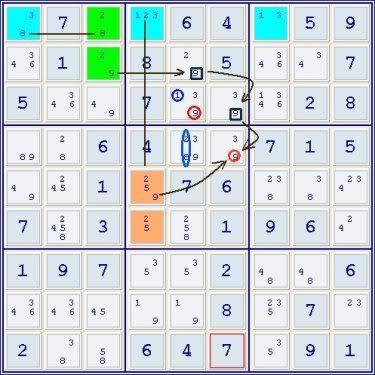- Code: Select all
*-----------*
|...|.64|..9|
|.1.|8..|...|
|5..|7..|.28|
|---+---+---|
|..6|4..|7.5|
|...|...|...|
|7.3|..1|9..|
|---+---+---|
|19.|..2|..6|
|...|..8|.7.|
|2..|64.|...|
*-----------*
and here is where I am stuck:
- Code: Select all
38 7 28 | 123 6 4 | 13 5 9
346 1 29 | 8 29 5 | 346 34 7
5 346 49 | 7 139 39 | 1346 2 8
------------------+--------------------+-------------------
89 28 6 | 4 2389 39 | 7 1 5
49 245 1 | 259 7 6 | 238 38 234
7 2458 3 | 25 258 1 | 9 6 24
------------------+--------------------+-------------------
1 9 7 | 35 35 2 | 48 48 6
346 346 45 | 19 19 8 | 235 7 23
2 38 58 | 6 4 7 | 35 9 1
I can't see any regular fish (there may be sashimi, mutant or franken fish that I can't see, I'm not good with fish), xy-wings, xyz-wings, gordonian rectangles, chains, bilocation cycles or bivalue graphs. Obviously I'm not seeing *something*, I just can't figure out what it is.
Please help? The author (Frank Longo) says that every puzzle in the book is fair, with no guessing required, so there must be SOMEthing in there that I'm just not seeing.
I'm new to the forum, and I don't understand the notation that is used around the Sudoku forums on the internet, so if you use such notation, please explain it, or you won't be doing me any good at all.
Thanks!
-Rose


